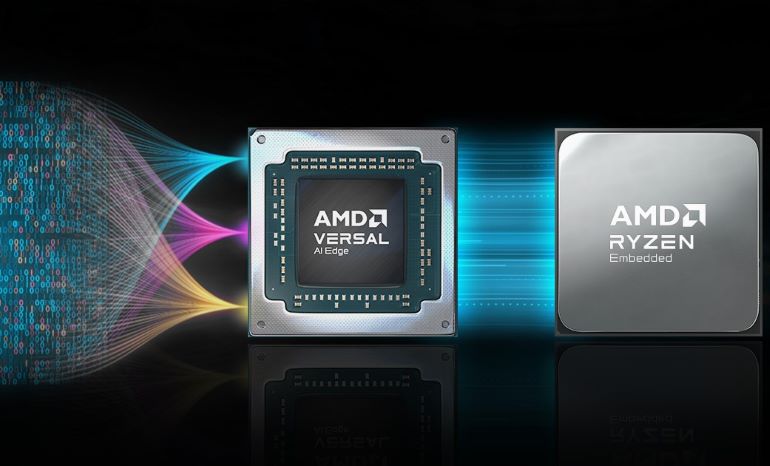|
Listen to this article |

The new AMD Embedded+ architecture for high-performance compute. Source: Advanced Micro Devices
Robots and other smart devices need to process sensor data with a minimum of delay. Advanced Micro Devices Inc. today launched AMD Embedded+, a new computing architecture that combines AMD Ryzen Embedded processors with Versal adaptive systems on chips, or SoCs. The single integrated board is scalable and power-efficient and can accelerate time to market for original design manufacturer, or ODM, partners, said the company.
“In automated systems, sensor data has diminishing value with time and must operate on the freshest information possible to enable the lowest-latency, deterministic response,” stated Chetan Khona, senior director of industrial, vision, healthcare, and sciences markets at AMD, in a release.
“In industrial and medical applications, many decisions need to happen in milliseconds,” he noted. “Embedded+ maximizes the value of partner and customer data with energy efficiency and performant computing that enables them to focus in turn on addressing their customer and market needs.”
For more than 50 years, AMD said it has innovated in high-performance computing, graphics, and visualization technologies. The Santa Clara, Calif.-based company claimed that Fortune 500 businesses, billions of people, and research institutions around the world rely on its technology daily.
In the two years since it acquired Xilinx, AMD said it has seen increasing demand for AI in industrial/manufacturing, medical/surgical, smart-city infrastructure, and automotive markets. Not only can Embedded+ support video codecs and AI inferencing, but the combination of Ryzen and Versal can enable real-time control of robot arms, Khona said.
“Diverse sensor data is relied upon more than ever before, across applications,” said Khona in a press briefing last week. “The question is how to get sensor data from autonomous systems into a PC if it isn’t on a USB or some consumer interface.”
 Learn from Agility Robotics, Amazon, Disney, Teradyne and many more.
Learn from Agility Robotics, Amazon, Disney, Teradyne and many more.
AMD Embedded+ paves a path to sensor fusion
“The market for bringing processing closer to the sensor is growing rapidly,” said Khona. The use cases for embedded AI are growing, with the machine vision market growing to $600 million and sensor data analysis to $1.4 billion by 2028, he explained.
“AMD makes the path to sensor fusion, AI inferencing, industrial networking, control, and visualization simpler with this architecture and ODM partner products,” Khona said. He described the single mother board as usable with multiple types of sensors, allowing for offloaded processing and situational awareness.
AMD said it has validated the Embedded+ integrated compute platform to help ODM customers reduce qualification and build times without needing to expend additional hardware or research and development resources. The architecture enables the use of a common software platform to develop designs with low power, small form factors, and long lifecycles for medical, industrial, and automotive applications, it said.
The company asserted that Embedded+ is the first architecture to combine AMD x86 compute with integrated graphics and programmable I/O hardware for critical AI-inferencing and sensor-fusion applications. “Adaptive computing excels in deterministic, low-latency processing, whereas AI Engines improve high performance-per-watt inferencing,” said AMD.
Ryzen Embedded processors, which contain high-performance Zen cores and Radeon graphics, also offer rendering and display options for an enhanced 4K multimedia experience. In addition, it includes a built-in video codec for 4K H.264/H.265 encode/decode.
The combination of low-latency processing and high performance-per-watt inferencing enables high performance for tasks such as integrating adaptive computing in real time with flexible I/O, AI Engines for inferencing, and AMD Radeon graphics, said AMD.
It added that the new system combines the best of each technology. Embedded+ enables 10GigE vision and CoaXpress connectivity to camera via SFP+, said AMD, and image pre-processing occurs at pixel clock rates. This is especially important for mobile robot navigation, said Khona.
Sapphire delivers first Embedded+ ODM system
Embedded+ also allows system designers to choose from an ecosystem of ODM board offerings based on the architecture, said AMD. They can use it to scale their product portfolios to deliver performance and power profiles best suited to customers’ target applications, it asserted.
Sapphire Technology has built the first ODM system with the Embedded+ architecture, the Sapphire Edge+ VPR-4616-MB, a low-power Mini-ITX form factor motherboard. It offers the full suite of capabilities in as low as 30W of power by using the Ryzen Embedded R2314 processor and Versal AI Edge VE2302 Adaptive SoC.
The Sapphire Edge+ VPR-4616-MB is also available in a full system, including memory, storage, power supply, and chassis. Versal is a programmable network on a chip that can be tuned for power or performance, said AMD. With Ryzen, it provides programmable logic for sensor fusion and real-time controls, it explained.
“By working with a compute architecture that is validated and reliable, we’re able to focus our resources to bolster other aspects of our products, shortening time to market and reducing R&D costs,” said Adrian Thompson, senior vice president of global marketing at Sapphire Technology. “Embedded+ is an excellent, streamlined platform for building solutions with leading performance and features.”
The Embedded+ qualified VPR-4616-MB from Sapphire Technology is now available for purchase.





